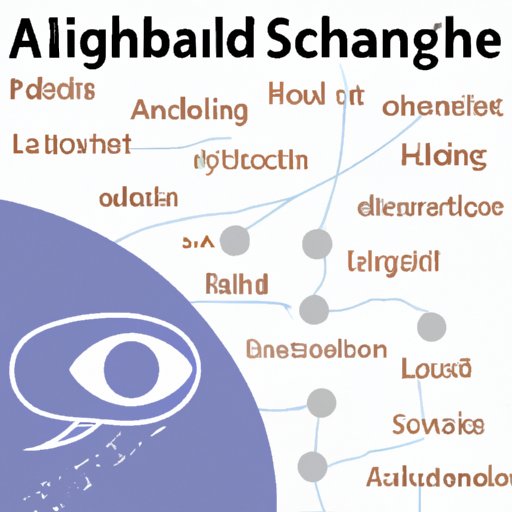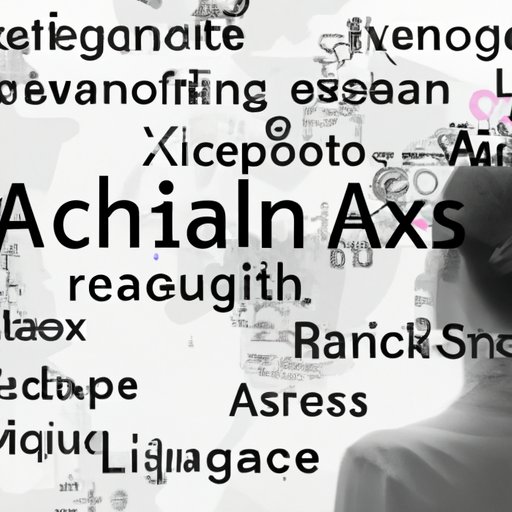Introduction
Artificial intelligence (AI) is a form of technology that enables computers to think and act like humans. It is used in various fields, from robotics to healthcare, and has become an integral part of our everyday lives. One of the most important aspects of AI is its ability to understand language. By using natural language processing, machine learning, and artificial neural networks, AI can comprehend and respond to spoken and written words.

Exploring the Natural Language Processing Techniques Used for AI Understanding of Language
Natural language processing (NLP) is the process of teaching computers to interpret and understand human language. It uses a set of techniques to analyze text and speech, with the goal of helping computers understand what people are saying. NLP is essential for AI language comprehension and is used in applications such as voice recognition and natural language generation.
The primary NLP techniques used in AI language comprehension are syntactic and semantic analysis. Syntactic analysis involves breaking down sentences into their component parts and analyzing the structure of the sentence. This helps AI understand the meaning of words and phrases in the context of the sentence. Semantic analysis focuses on the meaning of words and phrases, rather than their structure. It helps AI identify the relationships between words and determine the intended message of the speaker or writer.

Examining How Machine Learning is Used to Teach AI Language Comprehension
Machine learning is a type of artificial intelligence that enables computers to learn from data without explicit programming. It uses algorithms to analyze large amounts of data and identify patterns and trends. Machine learning is used to teach AI language comprehension by training it to recognize speech patterns and text structures.
The machine learning algorithms used for AI language comprehension include supervised learning, unsupervised learning, and reinforcement learning. Supervised learning algorithms are used to classify data and make predictions based on labeled data sets. Unsupervised learning algorithms are used to identify clusters and patterns in unlabeled data sets. Reinforcement learning algorithms are used to improve the performance of AI systems over time by rewarding them for correct decisions.
Using machine learning algorithms to teach AI language comprehension has several advantages. It allows AI systems to learn quickly and accurately, and makes it easier to incorporate new data into the system. Furthermore, machine learning algorithms can be used to detect subtle nuances in language, such as sarcasm and figurative language, which can be difficult for AI systems to understand otherwise.
Investigating the Role of Artificial Neural Networks in Language Understanding by AI
Artificial neural networks (ANNs) are computer models that simulate the behavior of biological neural networks. They are composed of interconnected nodes that process information and can be used to model complex relationships. ANNs are used to teach AI language comprehension by giving it the ability to recognize patterns in language and predict the correct response.
ANNs are used to teach AI language comprehension by modeling the structure of language. This includes identifying the relationships between words and phrases, recognizing the context of conversations, and understanding the meaning of words and phrases. ANNs can also be used to generate language, allowing AI to respond to spoken and written messages in a more natural way.
Using ANNs to teach AI language comprehension has several advantages. It enables AI systems to recognize subtle nuances in language, such as sarcasm and figurative language, and it allows them to generalize knowledge to different contexts. Furthermore, ANNs can be used to generate language, enabling AI to respond to spoken and written messages in a more natural way.
Analyzing the Impact of Text-to-Speech and Speech-to-Text Technologies on AI Language Understanding
Text-to-speech (TTS) and speech-to-text (STT) technologies are used to enable AI systems to understand spoken and written language. TTS technologies convert written language into spoken language, while STT technologies convert spoken language into written language. These technologies allow AI systems to interact with humans in a more natural way and understand spoken and written messages.
TTS and STT technologies are used to teach AI language comprehension by enabling it to recognize speech patterns and text structures. They also allow AI systems to respond to spoken and written messages in a more natural way, making it easier for humans to interact with them. Furthermore, these technologies can be used to detect subtle nuances in language, such as sarcasm and figurative language, which can be difficult for AI systems to understand otherwise.

Evaluating the Benefits and Drawbacks of AI Understanding of Language
AI understanding of language offers many benefits, including improved accuracy and speed, increased efficiency, and better customer service. By understanding language, AI systems can respond to spoken and written messages in a more natural way, making it easier for humans to interact with them. Furthermore, AI understanding of language can be used to detect subtle nuances in language, such as sarcasm and figurative language, which can be difficult for AI systems to understand otherwise.
However, AI understanding of language also has some drawbacks. AI systems can struggle to understand complex language, and they may not always produce accurate results. Furthermore, AI systems can be prone to bias, as they may interpret language differently depending on their own experiences and preconceived notions. Finally, AI understanding of language can be expensive and time-consuming to implement.
Conclusion
In conclusion, AI understanding of language is becoming increasingly important as AI becomes more integrated into our lives. Natural language processing, machine learning, and artificial neural networks are all used to teach AI language comprehension, and text-to-speech and speech-to-text technologies are used to enable AI systems to understand spoken and written messages. While AI understanding of language offers many benefits, it also has some drawbacks, such as potential bias and inaccuracy. Overall, AI understanding of language is an important area of research that will continue to evolve as AI technology advances.
(Note: Is this article not meeting your expectations? Do you have knowledge or insights to share? Unlock new opportunities and expand your reach by joining our authors team. Click Registration to join us and share your expertise with our readers.)
